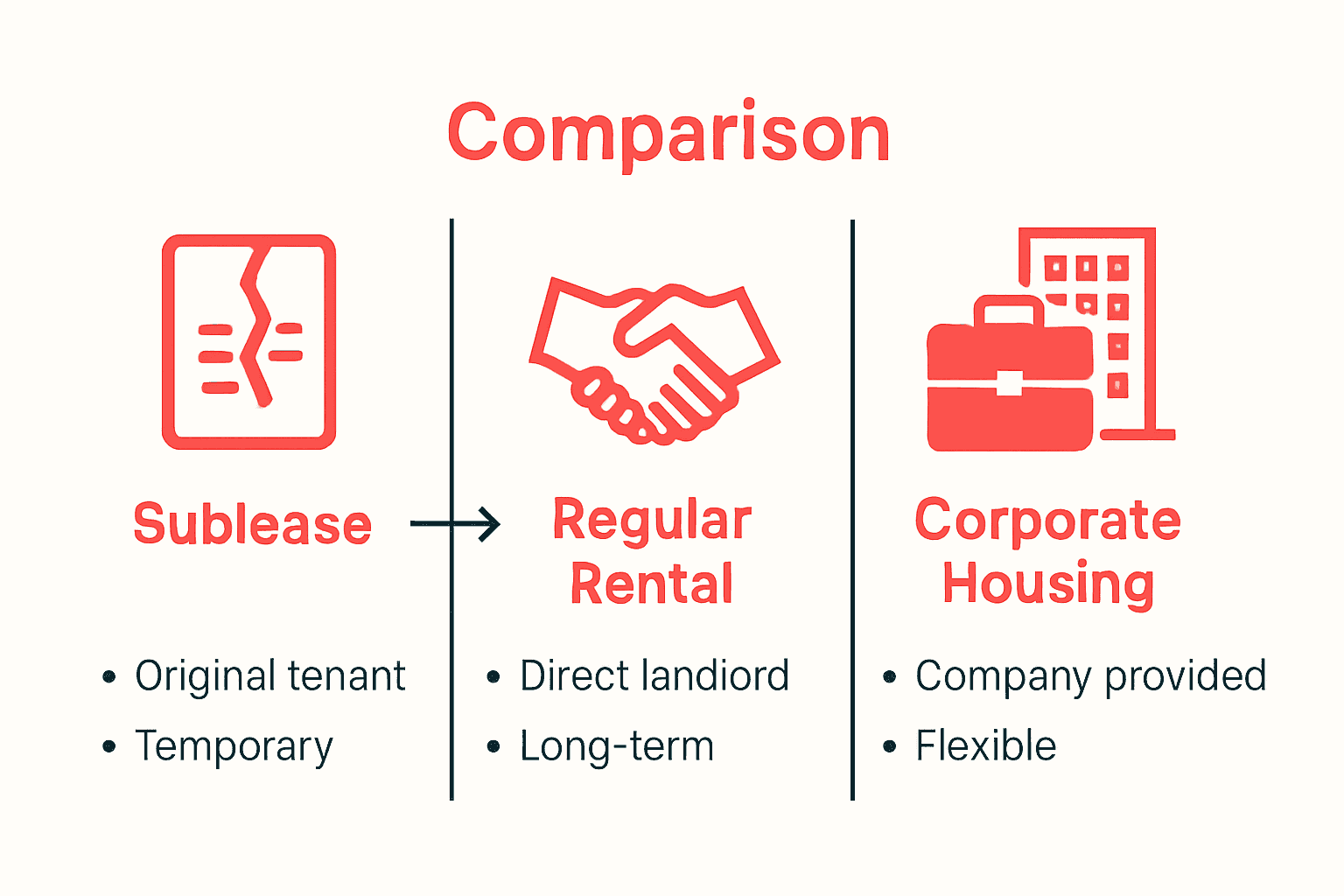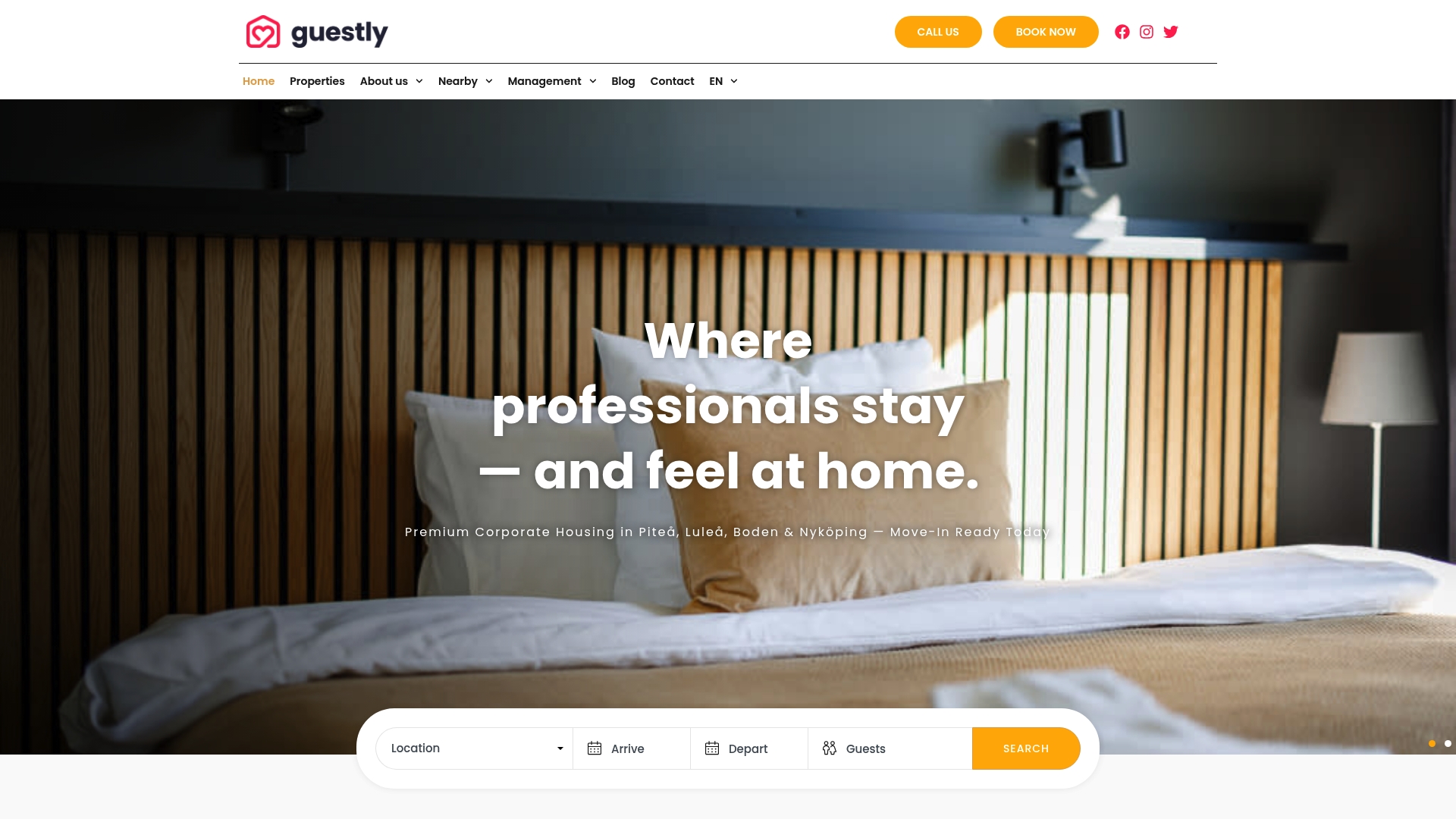Most british tenants encounter confusion when it comes to subleasing, even though over 30 percent of urban renters consider subletting during temporary moves. This legal arrangement lets an original tenant rent out their home to someone else while still holding responsibility to the landlord. Understanding subleasing is crucial for anyone navigating changing housing needs, since it affects rights, responsibilities, and even long-term property security. This guide breaks down the essentials so you can approach subleasing with clarity and confidence.
Table of Contents
- Sublease Meaning: The Core Definition
- How Subleasing Works in Sweden
- Sublease, Regular Rental, and Corporate Housing
- Common Owner Concerns and Risks
- Guestly Homes: A Structured Alternative
- Checklist for Owners Considering Subleasing
Key Takeaways
| Point | Details |
|---|---|
| Sublease Overview | A sublease involves the original tenant transferring occupancy rights to a new tenant while retaining obligations to the landlord. |
| Legal Requirements in Sweden | Subleasing requires explicit permission from the landlord and adherence to specific conditions to ensure compliance with local regulations. |
| Distinctions Among Housing Options | Subleasing differs from regular rentals and corporate housing, introducing complexities in responsibility and relationship dynamics. |
| Owner Considerations for Subleasing | Property owners must navigate financial and legal risks through rigorous tenant screening and comprehensive documentation. |
Sublease Meaning: The Core Definition
A sublease represents a nuanced legal arrangement where an original tenant transfers partial or complete occupancy rights to another individual, while maintaining their primary responsibility to the original property owner. According to hhkol, a sublease involves a tenant (sub-lessor) renting out their leased property to another party (sub-tenant), creating a secondary rental agreement while the original lease remains in effect.
The core mechanics of subleasing revolve around three primary participants: the property owner (landlord), the original tenant (sub-lessor), and the new tenant (subtenant). In this intricate arrangement, the original tenant essentially becomes a secondary landlord, retaining legal and financial obligations to the property owner while simultaneously establishing a separate contractual relationship with the subtenant. As soihtu explains, subleasing often occurs when a primary tenant rents out a portion of their apartment to another individual, forming a distinct agreement between themselves and the subtenant.
Critical distinctions define a sublease’s legal landscape. Unlike direct rental agreements, subleasing introduces complex layers of responsibility and potential risk. The original tenant remains ultimately accountable for:
- Consistent rent payment to the property owner
- Maintaining the property’s condition
- Ensuring the subtenant adheres to original lease terms
- Managing potential damages or lease violations
This unique arrangement provides flexibility for tenants facing temporary housing transitions while presenting both opportunities and potential challenges for all involved parties.
How Subleasing Works in Sweden
In Sweden, subleasing operates under a structured legal framework that prioritizes tenant rights and property owner protections. According to support.samtrygg, subleasing a tenancy-apartment requires explicit permission from the landlord, while subleasing a condominium necessitates approval from the housing cooperative. This nuanced approach ensures that property rights and tenant responsibilities remain clear and legally defined.
The subleasing process in Sweden involves several critical steps and considerations. Chalmersstudentbostader highlights that subleasing mandates prior consent from the property owner, with specific conditions that must be met. These conditions typically include:
- Presenting valid and compelling reasons for subleasing
- Demonstrating temporary relocation needs
- Providing comprehensive details about the potential subtenant
- Ensuring compliance with original lease terms
Key eligibility factors for subleasing in Sweden often include work-related relocation, extended academic studies, or temporary international assignments. The original tenant must typically prove that their absence is temporary and that they intend to return to the property. Housing cooperatives and landlords carefully evaluate these circumstances to protect both property integrity and tenant rights.

Navigating the Swedish subleasing landscape requires meticulous documentation and transparent communication. Property owners and tenants must collaborate to ensure that all legal requirements are met, including potential background checks for subtenants, clear contractual agreements, and defined rental terms. While the process can seem complex, it provides a structured mechanism for tenants to manage temporary housing transitions while maintaining their primary rental agreements.
Sublease, Regular Rental, and Corporate Housing
Understanding the distinctions between subleasing, regular rental, and corporate housing is crucial for navigating the complex landscape of property arrangements. According to ofixu, these three models represent unique approaches to temporary accommodation, each with distinct legal and operational characteristics. While they may seem similar on the surface, their underlying structures and responsibilities differ significantly.
Kliently highlights the key differentiators among these housing models:
Regular Rental
- Direct agreement between landlord and tenant
- Single, straightforward lease contract
- Tenant has direct relationship with property owner
- Typically longer-term, more stable arrangement
Sublease
- Original tenant becomes a secondary landlord
- Requires explicit permission from primary landlord
- Involves a more complex contractual relationship
- Often used for temporary or situational housing needs
Corporate Housing
- Specifically designed for business professionals
- Fully furnished and equipped
- Managed by companies for employee accommodations
- Typically short to medium-term stays
The nuanced differences extend beyond mere contractual arrangements. Regular rentals provide the most straightforward housing solution, with clear lines of responsibility between landlord and tenant. Subleasing introduces an additional layer of complexity, as the original tenant assumes partial landlord responsibilities. Corporate housing, meanwhile, represents a specialized approach tailored to professional mobility and temporary work assignments.
For property owners and tenants alike, understanding these distinctions is essential. Each model offers unique advantages and potential challenges, making it crucial to select the most appropriate arrangement based on specific needs, duration of stay, and individual circumstances. While the legal frameworks might seem intricate, careful consideration of these housing models can lead to more effective and satisfactory living arrangements.

Common Owner Concerns and Risks
Subletting presents a complex landscape of potential challenges for property owners, with legal and financial risks that demand careful consideration. According to Housing International, housing cooperatives are increasingly concerned that relaxed subletting regulations may lead to speculation and destabilization within housing markets, potentially undermining tenant security and property value management.
Kliently highlights several critical risks that property owners must navigate:
Financial Risks
- Potential loss of rental income if subtenant fails to pay
- Increased maintenance and repair costs
- Risk of property value depreciation
- Unexpected expenses from property damage
Legal Risks
- Unauthorized subleasing can result in lease termination
- Challenges in enforcing contractual obligations
- Potential violations of housing cooperative regulations
- Complex legal proceedings for dispute resolution
The most significant concerns revolve around tenant selection and ongoing property management. Property owners must implement rigorous screening processes to mitigate risks, including comprehensive background checks, thorough rental history verification, and detailed sublease agreements that clearly define responsibilities and potential penalties.
Navigating these risks requires a proactive and strategic approach. Successful property owners develop comprehensive risk management strategies that include detailed documentation, regular property inspections, and clear communication channels with both primary tenants and subtenants. While subletting can offer financial flexibility, it demands a sophisticated understanding of legal frameworks and potential vulnerabilities in the rental ecosystem.
Guestly Homes: A Structured Alternative
Guestly Homes emerges as a strategic solution for property owners seeking a sophisticated and reliable approach to property management and subleasing. According to Housing International, maintaining tenant security and community stability within housing cooperatives requires structured subletting practices – a principle that Guestly Homes embodies through its carefully designed operational models.
The company offers two primary management approaches that address the complex landscape of property rental:
Revenue Share Model
- Owners and Guestly share earnings (60/40 or 70/30 split)
- Flexible exit clauses
- Ideal for owners seeking partnership and potential upside
- Maintains owner’s involvement and investment perspective
Arbitrage Model
- Guestly signs long-term lease (3-5 years)
- Pays fixed rent to property owner
- Manages property independently
- Provides predictable, stable income stream
As Kliently emphasizes, engaging professional services can provide a structured approach to subletting that ensures regulatory compliance and protects all parties’ interests. Guestly Homes takes this principle further by not just managing properties, but transforming them into high-performance assets with minimal owner involvement.
The company’s approach goes beyond traditional property management. By treating each property as a dynamic asset and leveraging sophisticated operational strategies, Guestly Homes delivers a quiet, intelligent solution that reduces complexity for property owners while maximizing potential returns. Their model represents a modern, professional alternative to traditional rental arrangements, offering property owners peace of mind and financial optimization.
Checklist for Owners Considering Subleasing
Subletting a property requires meticulous preparation and a comprehensive understanding of legal and operational requirements. According to Chalmers Student Bostader, owners must obtain landlord approval, ensure appropriate insurance coverage, and clearly define responsibilities in a written agreement before proceeding with subleasing.
A strategic pre-subleasing checklist should encompass the following critical elements:
Legal Preparedness
- Obtain explicit written permission from primary landlord
- Review original lease agreement for subletting clauses
- Understand local housing regulations
- Consult legal professional for comprehensive guidance
Documentation Requirements
- Create detailed sublease agreement
- Verify subtenant’s background and financial stability
- Document property’s current condition
- Establish clear communication protocols
Financial Considerations
- Determine appropriate rental pricing
- Establish rent collection mechanisms
- Create contingency fund for potential vacancies
- Understand tax implications of subleasing
Soihtu emphasizes that owners must proactively notify the landlord, draft comprehensive written agreements, and ensure subtenants strictly adhere to all housing rules and regulations. This approach minimizes potential conflicts and protects the owner’s long-term interests.
Successful subleasing demands a systematic, well-researched approach. Property owners who invest time in understanding regulatory requirements, developing robust documentation, and maintaining transparent communication significantly reduce potential risks. While the process might seem complex, a structured and informed strategy can transform subleasing from a potential challenge into a valuable property management opportunity.
Simplify Subleasing with Guestly Homes for Swedish Property Owners
The challenges of managing subleases in Sweden are clear. You need landlord permission, careful tenant screening, and airtight agreements to avoid financial and legal risks. The article highlights how complex these responsibilities become when you take on the role of a “secondary landlord” with all associated duties. You want stability, trust, and hands-off management without sacrificing income or control.
Guestly Homes offers precisely that solution. We transform your property into a premium, fully managed asset that delivers consistent returns with minimal effort on your part. Whether you prefer the flexibility of our Revenue Share Model or the predictability of our Arbitrage Model, we handle every detail from tenant curation to maintenance. This means no more worrying about lease violations or fluctuating rent payments. Instead, you gain a stable and professional subleasing partner who values long-term property performance and tenant security.
Explore how we provide a turnkey path to hassle-free property management at Guestly Homes and understand our tailored services at our business model page. For property owners looking for expert guidance on optimizing rental income while avoiding the pitfalls of unmanaged subleasing, discover Guestly Homes today.

Take control of your property with confidence and let Guestly Homes handle the complexities of subleasing for you. Act now to secure stable income streams and benefit from Sweden’s premium housing market with trusted, expert support.
Frequently Asked Questions
What does it mean to sublease a property?
Subleasing a property means that the original tenant (sub-lessor) rents out their leased space to another individual (subtenant) while retaining their responsibilities to the landlord.
What permissions are required for subleasing in Sweden?
In Sweden, explicit permission from the landlord is required for subleasing a tenancy-apartment, and approval from the housing cooperative is necessary for subleasing a condominium.
What are the risks for property owners when allowing subleasing?
Property owners face financial risks such as potential loss of rental income, increased maintenance costs, and legal risks such as unauthorized subleasing which may lead to lease termination.
How can property owners protect themselves when subleasing?
Property owners can protect themselves by implementing rigorous screening processes for subtenants, maintaining clear and detailed sublease agreements, and conducting regular property inspections.



